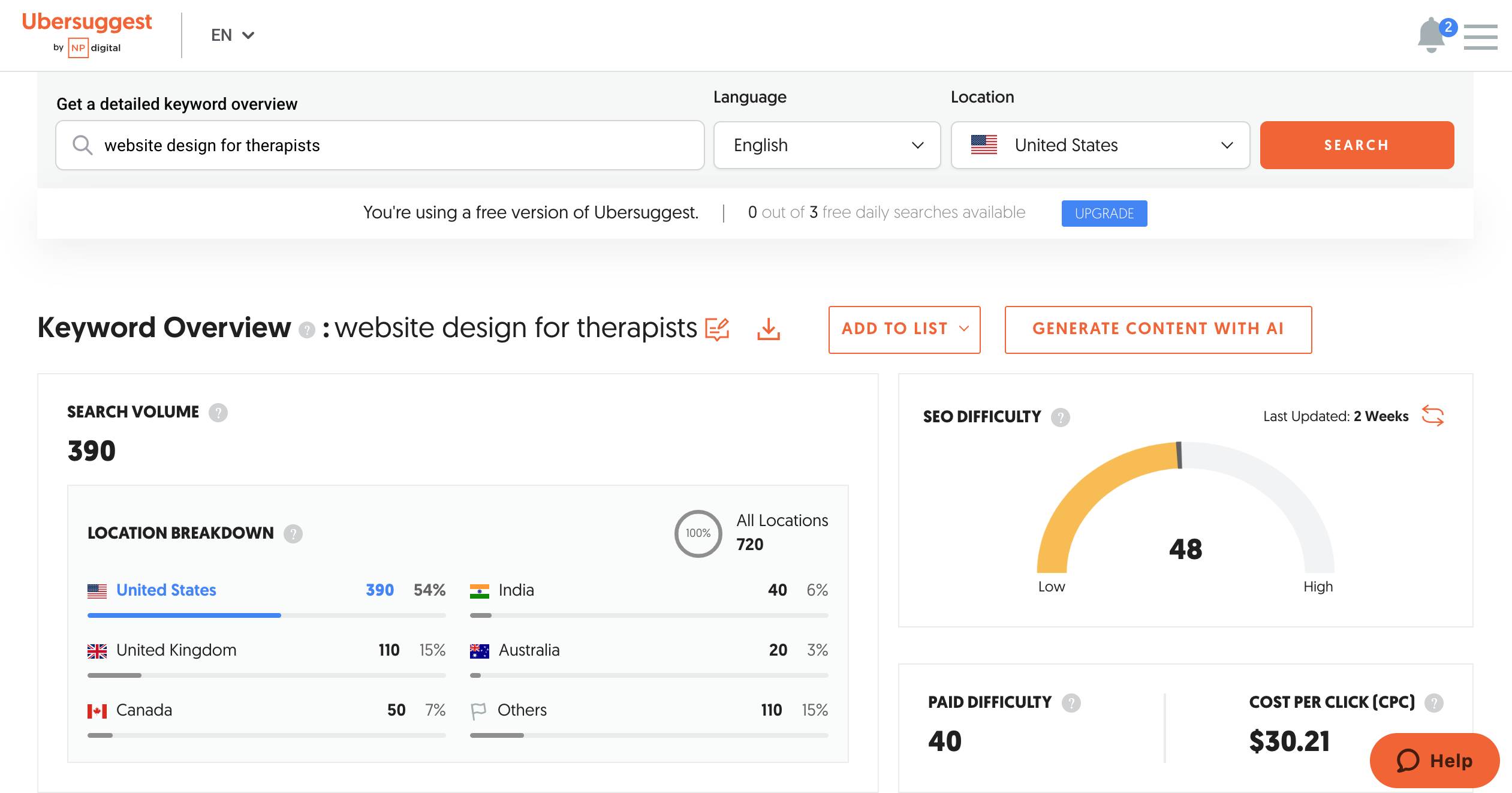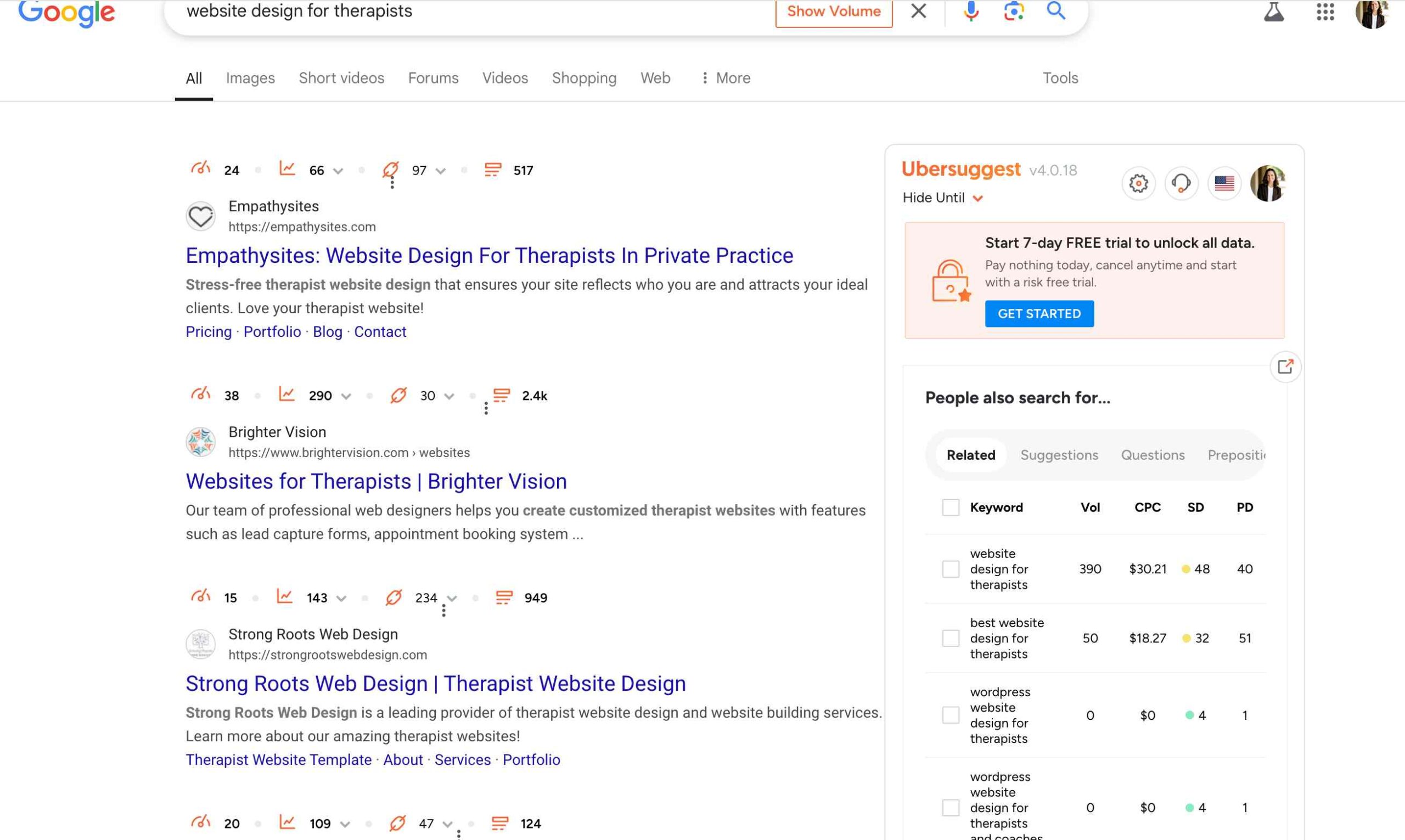Therapist Website SEO Best Practices: How to Rank Higher and Attract More Clients
April 9, 2025
- What is SEO and Why Does It Matter?
- Local SEO for Therapists: Why It's So Important
- The Power of Niches: Should You Create Separate Pages for Your Specialties?
- Keyword Research: How to Identify the Right Keywords
- Setting Up Google Analytics and Google Search Console
- On-Page Therapist Website SEO: Meta Descriptions, Page Titles, and URL Structure
- Image Optimization
- Backlinking: How It Helps Your SEO
- Conclusion: Start Implementing These SEO Best Practices Today!
Hi there! I’m Jordin, a web designer who specializes in creating websites that are not only aesthetically pleasing but also functional—designed to help you convert your ideal clients. Over the years, I’ve worked with many therapists and learned key strategies for improving their website SEO and getting found by more clients. Whether you’re just starting your practice or have been around for a while, therapist website SEO is crucial for making sure you’re visible online when potential clients are searching for services like yours.
In this post, I’ll walk you through SEO best practices for therapist websites, including the basics of SEO, why it matters, how to improve your local SEO, and how to make sure your website is set up for success.
What is SEO and Why Does It Matter?
Before we dive into the specifics, let’s break down SEO (Search Engine Optimization). SEO is the process of optimizing your website to help it appear in search engine results. This means making your site more attractive to Google and other search engines so that when potential clients search for terms like “therapist near me” or “therapist in [state name],” they find your website.
SEO is essential for making sure your business is visible and easy to find. With so many therapists competing online, if your website isn’t optimized, you’re missing out on a lot of opportunities.
Local SEO for Therapists: Why It’s So Important
Local SEO is especially crucial for therapists, as most of your clients will be searching for a therapist in their local area. If you offer therapy in multiple states, it’s a great idea to create separate pages for each location—this helps you target keywords specific to those locations and gives each page a better chance to rank for those areas.
For example, you can have a page targeting “Therapist in New Jersey” and another for “Therapist in New York”. By doing this, you’re giving Google more specific information about your services in each area, which can help those pages rank higher for their respective regions.
What You Need for Local SEO
One of the best ways to improve your local SEO is by making sure that your name, address, and phone number (NAP) are consistent across all of your platforms. This means having the exact same business name, address, and phone number listed on your website, social media pages, online directories, and anywhere else it appears online. Google gets confused when this information doesn’t match, which can negatively affect your search rankings. So, consistency is key!
Additionally, Google My Business is an important tool for therapists to use. Claim and update your business profile so you can show up in local search results (such as Google Maps). It’s a must for any therapist looking to attract local clients.
Key Takeaway: Multiple State Locations? Create Separate Pages
If you offer therapy in multiple states or regions, create a separate page for each one. It’s great for SEO because it helps you rank higher locally and ensures that your content is relevant to people searching for services in their area.
The Power of Niches: Should You Create Separate Pages for Your Specialties?
The saying “The riches are in the niches” is true when it comes to SEO! By focusing on specific specialties and creating individual pages for them, you’re able to target specialized keywords that speak directly to potential clients in need of those services.
For example, if you specialize in couples therapy, you should have a separate page dedicated to that service. Not only will this help with SEO by targeting relevant keywords like “couples therapy [city/state]”, but it also allows you to speak directly to those seeking that service. Potential clients will feel like you understand their needs, and you’re more likely to attract the right type of clients.
Why is this important for SEO? By having different pages for each of your specialties (like couples therapy, individual therapy, or child therapy), you’re able to optimize each page for specific keywords and reach a more targeted audience. This helps you rank higher on search engines for those specific terms, and it makes your content more relevant to what your audience is searching for.
Things to Keep in Mind:
- Having different pages for each specialty helps you focus your content on specific, relevant keywords.
- It allows you to create tailored content that speaks to your potential clients.
- Avoid keyword cannibalism: Make sure each page is focused on one specific keyword. You don’t want to target the same keyword on multiple pages because it can hurt your rankings.
Client Example: Emily Austin Therapy
For Emily Austin’s website, we designed unique pages for each of her specialties and locations. This included dedicated pages for services like OCD Therapy and Anxiety Therapy, as well as separate pages for her three locations in New York, New Jersey, and Florida. By creating these focused pages, we were able to target specific keywords for each service and location, giving her website a better chance of ranking for searches like “OCD Therapy in New York” or “Anxiety Therapist in Florida”.
This approach not only improved her site’s local SEO, but it also made her services more visible to potential clients in each region, driving more traffic and leads to her practice.
By separating location and specialty pages, we also helped Emily’s website speak directly to her ideal clients. Each page is tailored to address the unique needs of the people searching for that specific type of therapy. This personalization makes her website feel more relevant and approachable, encouraging potential clients to reach out and schedule an appointment. When your website directly addresses your clients’ needs, they’re much more likely to take action.
Keyword Research: How to Identify the Right Keywords
Knowing what keywords to target is essential for effective SEO. Keyword research is how you find out what potential clients are typing into Google when looking for a therapist. You want to know what terms are relevant to your practice and how competitive those terms are.
Free tools to help you with keyword research:
- Google Keyword Planner: A free tool from Google that helps you identify keywords with decent search volume and low competition.
- Ubersuggest: Another great tool to get keyword ideas based on your target audience.
- AnswerThePublic: A tool that shows you what people are asking about in relation to your niche.
Little step by step on how to properly do research for your keywords

1. Check Search Volume
What to do: Look up the keyword in a tool like Google Keyword Planner, Ahrefs, or Ubersuggest.
Target: Aim for 100-1,000 searches/month (adjust if your site has more authority).
2. Check Keyword Difficulty
What to do: Use Ahrefs, Moz, SEMrush, or Ubersuggest to check the keyword difficulty (KD) score.
Target: Choose keywords with KD under 40 for easier ranking. 40-60 is moderate. Avoid anything above 60 unless you have strong SEO resources.
3. Evaluate Relevance
What to do: Ensure the keyword is closely related to your products, services, or content.
Target: Only select keywords that directly align with what you offer.

4. Analyze the Competition on Page 1
What to do: Google the keyword and see what’s ranking on page 1.
Target: Check if the pages are from high-authority sites (e.g., DA above 50). Lower authority sites on page 1 are easier to beat.
5. Check Domain Authority (DA) of Competing Sites
What to do: Use Moz, Ahrefs, SEMrush, or Ubersuggest to check the DA of the top-ranking pages. Alternatively, use the Ubersuggest Chrome Extension to easily check domain authority directly in your Google search results. Install Ubersuggest Chrome Extension here.
Target: If most pages have DA above 50, it will be harder to rank. Look for opportunities where the DA is under 40 for easier competition.
6. Assess Your Site’s Ability to Compete
What to do: Compare your site’s DA to those ranking on page 1.
Target: If your DA is much lower, go for long-tail keywords or those with lower competition. Aim for niche opportunities with less authority needed.
Quick Recap:
Search Volume: 100-1,000 searches/month
Keyword Difficulty: Under 40 (ideally)
DA of Competing Sites: Under 40 is easier to rank against
Your Site’s DA: Go after keywords where your site has a chance to compete
Take these steps in order, and pause to make sure you’re targeting the most realistic keywords for your site!
Setting Up Google Analytics and Google Search Console
Before you start making SEO changes to your website, you must set up Google Analytics and Google Search Console. These two tools are essential for tracking your website’s performance and understanding how users interact with your site.
- Google Analytics helps you track how many people visit your site, where they come from, what pages they visit, and how long they stay. It gives you crucial data about your audience and helps you optimize your site based on real user behavior.
- Google Search Console provides insights into how your website is performing in search results, which keywords are driving traffic to your site, and if there are any technical issues with your website (like broken links).
Having these set up immediately is key, as it allows you to track the effectiveness of your SEO efforts and make data-driven decisions.
On-Page Therapist Website SEO: Meta Descriptions, Page Titles, and URL Structure
Now that your foundation is in place, it’s time to focus on the on-page SEO elements like meta descriptions, page titles, and URLs.
- Page Titles: The title of your page should include your target keyword and accurately reflect the content. For example, “Therapist in New Jersey | [Your Name] Therapy Services.”
- Meta Descriptions: These are the short descriptions that appear under your page title in search results. They should be concise and include your primary keywords to encourage clicks.
- URL Structure: URLs should be short, clear, and include relevant keywords. For example: yourwebsite.com/therapist-in-new-jersey
I go over how to optimize your Showit website in my freebie:

[convertkit form=7025438]
Image Optimization
A quick reminder: image optimization plays a significant role in SEO. You want to make sure your images are named correctly and include alt text with relevant keywords.
Here’s a blog post I wrote earlier on image optimization: How to Optimize Your Images on Your Showit Website. This goes into detail on how to make your images SEO-friendly, which is an essential part of on-page SEO.
Backlinking: How It Helps Your SEO
One of the most important aspects of SEO is backlinking—when other websites link back to your site. Backlinks are like votes of confidence from other websites, and they tell Google that your site is trustworthy and authoritative.
To improve your domain authority (which helps your SEO), get backlinks by:
- Listing your website on therapist directories like Psychology Today, TherapyDen, and GoodTherapy.
- Doing podcast interviews or guest blog posts for other websites or media outlets.
- Building relationships with other therapists or local businesses who can link back to your site.
Conclusion: Start Implementing These SEO Best Practices Today!
With these therapist website SEO best practices, you can start making improvements right away and see better results over time. The key is to be patient—SEO is a long-term game, but the more you implement these strategies, the more likely you are to rank higher and attract the right clients.
Don’t forget to track your progress with Google Analytics and Google Search Console! And if you’re looking to really dive into SEO, I’d love to help you design a website that’s not only beautiful but optimized for search.
Happy optimizing!
Pin for later:

Leave a Reply Cancel reply
You’ve built something incredible—don’t let a bad website hold you back.
You’ve built something
incredible—don’t
let a bad website hold you back.
Let’s move beyond just getting noticed. My goal is to position you as the top choice for your ideal clients—creating a brand and website that works for you and leaves a lasting impression. Together, we’ll build something that not only elevates your business but also drives meaningful growth. Ready to make it happen?
get more info
The Ultimate Guide to Setting Up SEO on Your Showit Website
FREEBIE
Supercharge your website's performance and unlock the secrets to higher rankings and increased traffic.
meet the blogger
i'm jordin
Hey there! I'm your friendly neighborhood tech nerd, design aficionado, and proud mom of two adorable troublemakers. Living in the heart of the Midwest with my husband, I'm on a mission to bring creativity and innovation to the digital world. When I'm not crafting pixel-perfect designs, you can find me chasing after my little ones, searching for a new restaurant to try, crate digging at a vinyl shop, or getting lost in a good book!
meet jordin
UNICA FORMO
branding and web design
est. 2016
© 2016-2025 unica formo. all rights reserved | privacy policy | Terms & Conditions
Office hours:
M-Th 8am-4pm est
Unica Formo, led by Jordin Brinn, specializing in personality-driven Showit website design and branding for creative service-based businesses in Ohio and Beyond.
